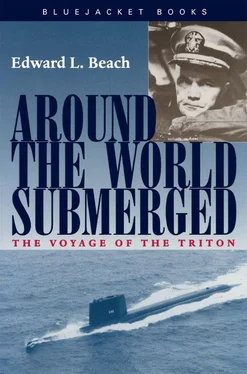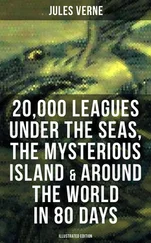Sunday, March sixth, was a day of rest, well deserved by all hands, and it was noteworthy for a special reason. Our growing concern over our fathometer had caused us to keep a closer-than-usual watch over it and over our regular search-sonar equipment, too. Searching out ahead, to our great pleasure, the latter at 1610 detected something that looked like a fifty-foot peak, or boulder, on the bottom. A moment later, as Triton herself passed over the spot, the fathometer registered the accuracy of the information. It was a comforting thought to know that our search sonar, designed to detect other ships and submarines, might be depended on to give us adequate warning of the approach of shoal water.
For two days, Triton roared toward Cape Horn, driving to make up lost time. On Monday, the seventh of March, we reached the storied Land’s End of the western hemisphere.
I had been giving some thought to how we should make proper observance of our passage from the Atlantic to the Pacific and finally hit upon a simple idea. In the Triton Eagle, I occasionally wrote a column called “The Skipper’s Corner,” to say things which it seemed might best be handled informally. On the seventh of March, therefore, the following entry appeared in “The Skipper’s Corner”:
As for Cape Horn, Triton will make a photographic reconnaissance on it, and then Mr. Roberts will make a National Geographic reconnaissance. Following this, as we cruise by for the 3rd or 4th time, I intend to require every man on the ship to come to the conning tower for a look. It is not a usual thing for a sailor to round the Horn these days. Many spend a lifetime and never do. By far the majority of US Navy sailors have never done it. Quite obviously, if you ever brag about having been around the Horn, the next question will either be, “Did you see it?” or “What does it look like?”
We intend to take a picture and I think it will be possible to make enough copies for all hands. But more than this, I want every man aboard to be able to say he’s seen it. Note: there will be no muster taken. If you don’t want to see the Horn, no one will force you. But you’ll wish you did later, because you’ll probably never get the chance again.
And then, that morning, I let it be known that in the old days, when a sailor went around the Horn, he hoped not to see the fabled Cape. If anyone aboard an old sailing ship, bucking wind and tide to double the Cape, sighted the forbidding promontory looming through the haze, it was considered that bad luck would follow very soon in the form of shipwreck on one of the most inhospitable coasts in the world.
More modern traditions, I announced, were different. A sailor who gazed upon Cape Horn deliberately would experience good luck for the rest of his seafaring career. Not only that, but all sailors who rounded the Horn automatically attained certain privileges denied ordinary mortals (one I did not recommend was that we might all have a pig tattooed on the calf of the right leg). Tradition has it also that sailors who have rounded the Horn may with impunity throw trash and slops to windward, and because of their great victory over the forces of the wind, none of it will ever be blown back into their faces. They also have the traditional right to wear their hats on the side of their heads instead of square above the eyebrows, as is required by Navy regulations (no one may wear it on the back of his head).
We made no muster, but we did keep an unofficial count of the persons coming into the conning tower for a look, in some cases to photograph the famous landmark with their own cameras (which they had been permitted to bring provided all film was turned in for checking). Every man wanted a look, and it was necessary to go back and forth five times in front of the Cape before all hands had had their view.
Triton’ s Log for the passage may give some idea of the conditions the old-timers faced in the days of sail.
Our observations of the conditions make it quite clear why it was such a tremendously difficult thing for old-time seafarers to weather this famous Cape. In the first place, though we are safely submerged and comfortable, Triton is rolling rather heavily. There is an unusually rough sea topside. Lt. James C. Hay, recently reported aboard from West Milton, has already established himself as a most competent diving officer—but he is having difficulty in maintaining ordered depth today. Good practice for young officers, and planesmen, too. We estimate the waves as 10 to 12 feet high and the wind about 25 knots from the west.
There are occasional rain squalls and the cloud coverage is rather low to the water. It is also noticed, after a few navigational cuts, that we are being set backwards, to the east, by a current of some 3 knots. Under such conditions it is easy to see how an old wind-jammer, trying to beat her way around the Cape, might find it almost impossible. Heavy winds and a strong current were both dead against her. Even a steamer would have her troubles at a time like this.
Although the conditions we have observed could hardly be called a storm, there is no doubt that any ship riding around Cape Horn on the surface today would be having a rough and uncomfortable trip. By contrast we are comfortable and snug.
Joe Roberts had spent practically his entire life as a photographer, and was one of the National Geographie’ s best. He also happened to be endowed with a genial personality which generated real affection on the part of officers and crew alike. An illustration of this was an incident that occurred in the conning tower as we passed Cape Horn. After taking his National Geographic pictures with half-a-dozen expensive cameras which he had slung around his neck, Joe had been about to make room for others by going below, when a sailor with a box camera appeared in the conning tower. Photographing through the periscope is by no means a simple procedure and Joe put down his cameras and other paraphernalia and turned back to help.
Sailor after sailor—and some officers, too—came to the conning tower with cameras, and to each one Commander Roberts patiently showed the tricks of the game, helped calculate and adjust the periscope diopter setting for the particular camera, plus the camera settings for the type of film and the outside light. Money could not have purchased the instruction and assistance these men were getting for nothing, and I wished I had had the sense to bring my own camera.
We had hoped the passage to Easter Island would be uneventful, after the rather strenuous navigation around the Falkland Islands and Cape Horn. I looked forward to a twenty-five-hundred-mile run through deep water, few problems, and a chance to read Thor Heyerdahl’s book, Aku-Aku, in which he describes his search for the origin of the Easter Islanders and his re-erection of one of the stone monoliths. It was, unfortunately, not to be so.
The tremendous capability of the nuclear power plant and the many changes in submarine operating procedures which it requires were brought firmly home the day after we passed Cape Horn, when we held a “loss of all main power” drill. All naval ships are required to carry out such exercises, for the obvious reasons that they develop the crew’s ability to cope with the problem should it occur in battle or as a result of some mishap.
Triton had, however, traveled some two thousand miles at great speed since she had last “gotten a good trim,” as submariners say. She had, moreover, changed from Atlantic waters off the River Plate to Pacific waters on the far side of Cape Horn, and was well on her way toward Easter Island. Our instruments, and those of Nick Mabry from the Hydro-graphic Office in Washington, gave us some idea of the change in salinity of the sea water—generally speaking, the Atlantic side of South America was saltier. We had taken aboard a good deal of water for various purposes, including running our evaporators and keeping our fresh water tanks full, and we had pumped varying amounts of water overboard to compensate for our computed decreased buoyancy.
Читать дальше












